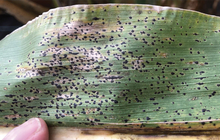A fungal disease new to Minnesota cornfields has been observed in the southeastern part of the state.
Tar spot in corn was first observed in the United States in 2015 in Illinois and Indiana. Its range is increasing steadily in Minnesota. Yield loss from tar spot does not occur every year but can be more than 30 bushels per acre when severe.
Dean Malvick, University of Minnesota Extension plant pathologist, has predicted and planned for tar spot’s introduction to Minnesota since then, working with his counterparts in Illinois and Indiana who have directly witnessed the disease’s effects. These relationships, in addition to his own ongoing research, have helped him answer questions on how best to predict, identify and manage tar spot.
Black raised spots that resemble small droplets of tar give tar spot its common name. All corn growth stages are susceptible to infection by Phyllachora maydis, the fungus that causes tar spot.
“Symptoms so far haven’t been observed until the middle of the growing season, in July or later,” says Malvick. “But it is also very likely that the fungus is in many more corn fields in Minnesota than we are aware of right now.”
The fungus survives the cold Minnesota winter in debris from previously infected crops and is thought to be spread by wind.
Malvick and an expert from Illinois delivered a webinar on tar spot this spring in Extension’s "Strategic Farming: Let’s talk crops" series.



